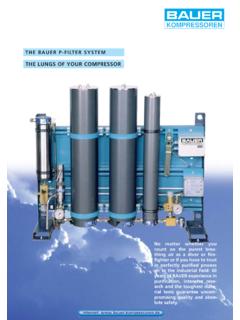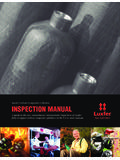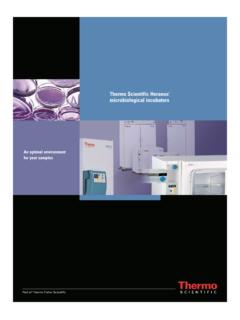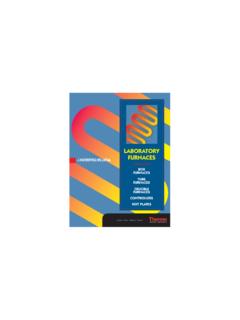Transcription of Thermo Valves Corporation - Scuba Engineer
1 Date: 07/31/05 Thermo Valves Corporation Scuba Diving Valves Maintenance Manual The Leader in High Pressure Technology 2005001-SMM Thermo Scuba Products are Sold Through Authorized Distributors Only Thermo PRO Thermo DIN Thermo Modular Page 2 This document and other information from Thermo Valves Corporation and Hamai Industries Limited, its subsidiaries and authorized distributors provides product, maintenance and/or options for further investigation by users having technical expertise. It is important that you analyze all aspects of your application and review the information concerning the product in the current product catalog. Due to the variety of operating conditions and applications for these products, the user, through his or her own analysis and testing, is solely responsible for making the final selection of the products assuring that all performance, safety and warning requirements of the application are met.
2 The products and processes described herein, including without limitation, product features, specifications, designs, availability and pricing, are subject to change by Thermo Valves Corporation and its subsidiaries at any time without notice. 2005001-SMM Thermo Valves Corporation Page 3 Table of Contents General Procedures Introduction 4 Annual Inspection 4 Pre-Inspection Procedures 4 Leak Inspection Procedure s 5 Disassembly Sequence 6 Assembly Sequence 7 Dip Tube Installation Instructions 9 Special Instructions for Modular Valves For 8043.
3 8063 & 8082 Series Modular Valves 10 For 9020 & 9040 Series H Connectors 11 For 8002 CTR W VLV & 8002 Center Bars 12 Exploded View Drawings 5251 Series Exploded View 13 5651, 5262 & 5282 Exploded View 14 8043, 8063 & 8082 Exploded View 15 9020 & 9040 Exploded View 16 8002 CTR W VLV Manifold Center Bar Exploded View 17 Parts Index 18 Scuba Valve Parts Warnings 20 Warnings, Terms and Conditions of Sale 21 Specifications for All Valves 23 2005001-SMM Page 4 Thermo Valves Corporation The Leader in High Pressure Technology SERVICE GUIDE FOR ALL Thermo BRAND Scuba Valves Thermo Scuba Valves are built to give the user years and years of trouble free service.
4 But for your Thermo Scuba valve to remain in it s peak performance and for ultimate safety, the valve must be inspected every year and full maintenance must be performed every five (5) years when your cyl-inder is hydrostatically tested for example in order to remain a safe and reliable valve. Exploded View drawings and a Parts Index can be found at the end of this manual. Annual Inspection Pre-Inspection Procedure Clean the exterior of the valve to facilitate inspection. WARNING: If cleaning agents are used, re-clean the exterior of the valve after inspection according to CGA Cleaning Equip-ment for Oxygen Service . Inspect the valve for bent, deformed, corroded or worn parts. Check the outlet of the valve for damaged, corroded or worn surfaces. This includes the valve body, handwheel and any visible areas of the valve. Check for any contamination in the outlet of the valve.
5 Confirm that the service pressure of the valve and safety assembly rating is correct for the cylin-der in which it is installed. 2005001-SMM Leak Inspection Procedure, Continued Leak Inspection Procedure Start with full working pressure in cylinder and a properly functioning regulator attached to the outlet. Open and Close the valve while it is installed in the cylinder and feel for smooth operation. If the valve seems to be difficult to operate or any roughness is felt, the valve must undergo full maintenance. Slowly open the valve fully, then back a quarter to half a turn. Remove handwheel from valve body by turning handwheel screw (Part #7) in a counterclock-wise direction and remove handwheel. DO NOT REMOVE BONNET NUT! Apply a non-ammonia soap and water solution (or a recognized leak detection agent such as Snoop ) to the valve gland nut area, the inlet neck o-ring area, the safety assembly area and the outlet area.
6 Allow the soap solution to sit for at least 15 seconds and check for signs of leakage. If you find leaks, the valve MUST undergo full maintenance. Turn the valve off with moderate force, then remove the regulator from the valve after the outlet pressure is completely blown off. Apply the soap solution to the valve outlet and check for leak-age. If after performing all of the items shown above and finding no irregularities or leakage, the valve may be returned to service. If any irregularities or leakage is found, the valve must undergo full maintenance. Thermo Valves Corporation Page 5 2005001-SMM Full Maintenance In addition to the annual inspection, full maintenance must be performed every five (5) years when your cylinder is hydrostatically tested for example in order to remain a safe and reliable valve. Full maintenance is also performed if any irregularities or leakage is found during the annual inspec-tion.
7 Pre-Inspection Procedure & Leak Inspection Procedure Perform the Pre-Inspection Procedure & Leak Inspection Procedure as shown in the previous Annual Inspection. Empty the air from the cylinder and thoroughly rinse the soap solution from the valve with clean, fresh water. Blow or wipe dry. Disassembly Sequence If the valve is being disassembled because leakage or other irregularities were found during the Annual Inspection and the leakage was not from the safety assembly area, do not replace the safety assembly (Item 12). If the valve is being disassembled for Full Maintenance at the five (5) year interval, replace safety assembly (Item 12), plug & seat assembly (Item 2,3), bonnet gasket (Item 16), packing (Item 5) and all o-rings. Before removing valve from cylinder, loosen bonnet nut (Item 4). WARNING! You must insure that the cylinder is empty before loosening bonnet nut.
8 Remove valve from cylinder using proper tool on the wrench flats only. Remove bonnet nut (Item 4) and stem (Item 8) from the valve body. Remove stem from bonnet nut and discard packing (Item 5) and stem o-ring (Item 17). Inspect stem and bonnet nut for any signs of defect, corrosion, damage to threads or any irregularity. Replace stem and/or bonnet nut if any defect or damage is found. Remove bonnet gasket (Item 16) from the valve body and discard it. The bonnet gasket must be removed from the valve before removing the plug & seat assembly (Item 2,3). Page 6 2005001-SMM Remove plug & seat assembly (Item 2,3) from valve body by rotating in a counter clockwise di-rection and discard. The plug & seat assembly must be replaced at every five (5) year inspection. Use compressed air to blow the seat area clean. Inspect for any damage to the inside of the valve or to the seat area.
9 If any damage is found on the inside of the valve or the seat area the valve must be condemned. Assembly Sequence Before re-assembly, use compressed air to blow off all the components of the valve including new replacement parts. Clean the valve and all parts according to CGA Cleaning Equipment for Oxygen Ser-vice . If the valve is an EAN Ready valve as sold by Thermo Valves , then clean and inspect the valve as per CGA Cleaning Equipment for Oxygen Service . Insert plug & seat assembly (Item 2,3) into valve and screw in a clockwise direction until the plug & seat assembly contacts the lower seat. The stem (Item 8) may be used to screw the plug & seat assembly into the valve. Install a new bonnet gasket (Item 16) into valve body. Lightly lubricate the stem o-ring (Item 17) with an oxygen compatible grease such as Christolube MCG 111. Insert stem o-ring (Item 17) on to the stem (Item 8).
10 Insert new packing (Item 5) on to the stem as shown in the diagrams at the end of this manual. Insert stem, stem o-ring and packing assem-bly into the bonnet nut (Item 4). Insert bonnet nut and stem assembly into valve body insuring that the slot in the stem engages the tang in the plug & seat assembly. Tighten bonnet nut hand tight. Remove inlet o-ring (Item 14) from the valve inlet and clean the valve inlet area with a dry cloth. Install a new inlet o-ring to the valve inlet. In case of Thermo -K valve, remove outlet o-ring (Item 19) and inspect outlet for any damage or corrosion. If damage or corrosion to the valve outlet is found, the valve must be condemned. Otherwise, replace outlet o-ring with new o-ring. Thermo Valves Corporation Page 7 2005001-SMM In case of Thermo -PRO valve, remove outlet adaptor (Item 24) with an appropriate allen wrench and remove o-rings (Item 23, 25) from the outlet adaptor.










